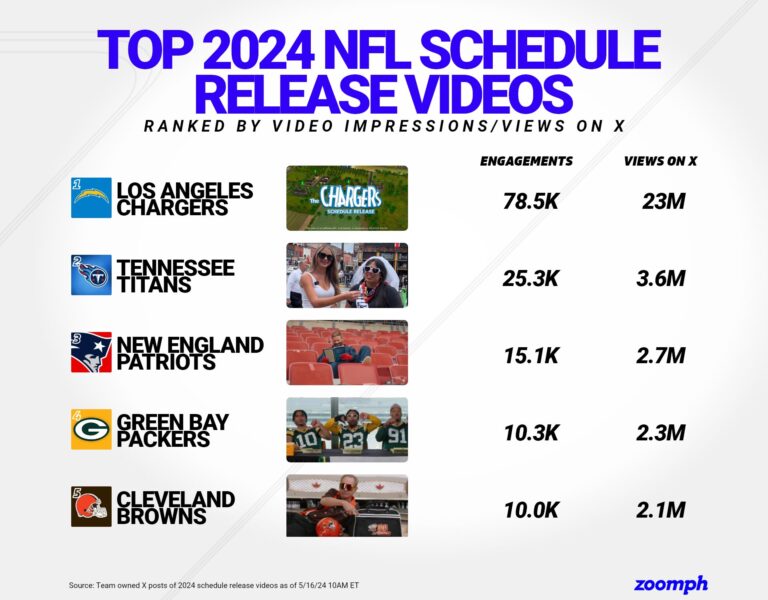
02 Jul How to Make Sports Content Go Viral – Proven Strategies
“Just make it go viral.” Chances are if you work in sports marketing, particularly as a social media manager, you’ve heard those five words more than once. The goal is always to go viral, but as we all know, it’s not as easy as it sounds.
And of course, the postgame win graphic and the record-setting moments always go viral. But how do you take a blank page and within 140 characters make it viral?
In this blog, we are going to discuss the importance of making viral moments without these supporting moments and share some recent examples of sports and the impact they created.
Why does going viral actually matter?
Everyone in sports wants to go viral, but have we ever stopped to ask why? Attention is currency, as famously trademarked by Zoomph CEO Amir Zonozi, but what does that mean? Going viral means more than having your post noticed. By building an audience that attaches to your brand and content elevates the trust they have in you and will keep them coming back.
“Over the course of a full 365-day calendar, what separates great social teams from good social teams are those who can creatively come up with ways to either engage their fan base or drive revenue when they don’t have the benefit of big team moments whose occurrences cannot be impacted by anyone other than the players”, says Arizona Coyotes Lead Digital Strategist Dan Marrazza
To measure the impact of this engagement great social teams create, Marrazza has been a “pioneer” of a metric he calls Exposure Rate. This is a metric that Marrazza began tracking in an earlier role with DraftKings back in 2018 that he since brought to the Coyotes, which he’s taken to another level working with our team at Zoomph.

As we know in sports, sponsorships are crucial to driving business. If you have a content team that delivers viral moments, in sponsored content your fans will deliver value to your brand partners and your brand partners will thank you for that.
Now that we’ve shared why this matters, we want to share a few examples and delve into what made these moments go viral.
NHL players play prank wars
Our first example of a content team creating a viral moment was a prank war between the Minnesota Wild’s Marc-Andre Fleury and Colorado Avalanche’s Brandon Duhaime.
Below each post, we have included the post’s Exposure Rate. Exposure Rate is calculated by dividing the number of post impressions by the number of profile followers and is used to measure. the distribution of your content relative to the size of your following, which in the process weights the “quality” of engagements versus the “quantity.”
For more insight into this metric, check out this previous blog from us that dives into this metric and its purpose more deeply.
This prank war received some extra flower power today…#GoAvsGo pic.twitter.com/BO37ZHFaSc
— Colorado Avalanche (@Avalanche) April 8, 2024
Exposure Rate: 51.74%
What makes this such a strong example of creating a viral moment in sports is that not only was this not a moment created by on-ice performance, but it also was not created by the social team. However, by the social team having the trust of their players to “document” the prank war, both teams were able to share a behind-the-scenes moment, while also sharing a few exchanges together, to deliver a polished and fun-spirited production for their fans. The team’s two videos combined totaled over 1.7M views on X.
Dew you need some toilet paper? 😏#mnwild x @NHL pic.twitter.com/bemS5IEFla
— Minnesota Wild (@mnwild) April 4, 2024
Exposure Rate: 33.22%
Biggest Day on the NFL calendar?
should we REALLY make our schedule release video in the sims?
— Los Angeles Chargers (@chargers) May 16, 2024
yes yes yesyes
yesyes yes yes yes
yes yes yes yes yes
yes yesyes yes yes
yes yesye yes yes
yes yes yesyes pic.twitter.com/MXzfAPyhe8
Exposure Rate: 627.25%
One team that has absolutely mastered NFL Schedule Release Day is the Los Angeles Chargers. Knowing their fan base demographic, which is another crucial data point in creating viral moments, the Chargers have created anime-themed video pieces to share their schedule.

As you can see from Zoomph’s NFL schedule release data, the Chargers this year outpaced the rest of the league, showing just how strong this content is for them and validates the time and effort put into creating this content.
To reiterate, the importance in this example is not just understanding the magnitude of the schedule release, but also understanding who your audience is and what content will make them excited to engage with your content.
Burritos can go viral too
@chipotle i’m working late, cuz i’m Chipotle
♬ original sound - Chipotle
Exposure Rate: 341.67%
While it seems simple, this worked so well because given the trend at the time, Chipotle was being talked about a lot, so when people saw that Chipotle themselves posted about it, it instantly led to viewers spreading it and engaging with it with top comments such as “Chipotle knows”, “Chipotle is BOLD for this!”, and “Chipotle scoops were not serving but the marketing is servingggg”. Yeah, I think the audience loved this video. At the time of this writing, the TikTok has over 8 million views and 912.9K likes, the most views on a Chipotle TikTok this year by over 4 million views.
So going Viral is easy?
Although we may have just made it sound so, going viral is far from easy, especially through creative means. It takes a lot of creative minds coming together to pull off the perfect execution with a lot of internal trust. In fact, this year there were only 33 instances in the NHL where a team amassed 500 retweets on a post on X where the medium was not win or moment relative or a chirp at another team/fan base. But with the right amount of homework and watching the rest of the industry also work, it can be done and duplicated.
To wrap up, we are going to include more examples below of sports teams who have recently produced viral performing content through creativity beyond game/match results to show our respect and appreciation for the work they have created to elevate the bar for sports social media.
nonstop 😤 pic.twitter.com/B4okkZPIZZ
— Boston Celtics (@celtics) June 8, 2024
Exposure Rate: 62.46%
mee watching gamee 6 tonighttr @Mets pic.twitter.com/0C62VPz02M
— McDonald's (@McDonalds) June 17, 2024
Exposure Rate: 23.16%
Hey @nyjets, since we’re in town do you want to get together on Friday for dinner? cause we have the same name. It could be like the @Giants & @SFGiants picnic in Totowa 😁
— Winnipeg Jets (@NHLJets) March 20, 2024
Exposure Rate: 90.18%
Preece & Chase!
— Stewart-Haas Racing (@StewartHaasRcng) September 25, 2023
We wanna go fast with @WonderBreadUSA and @OldSpice at Talladega. pic.twitter.com/oxGY2UgvRG
Exposure Rate: 102.51%









